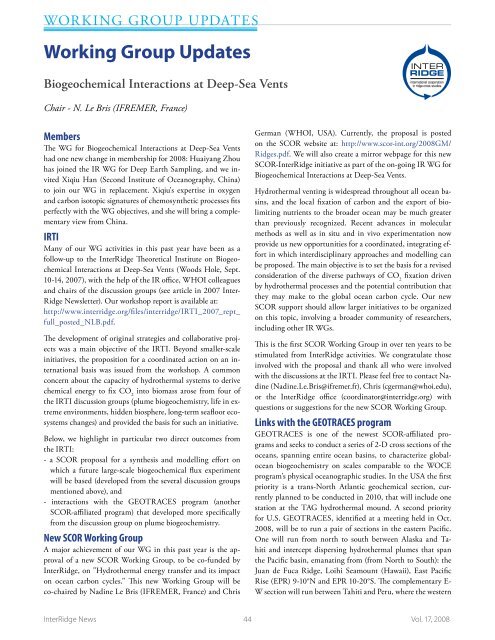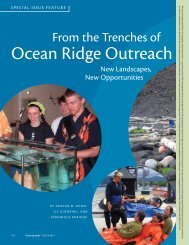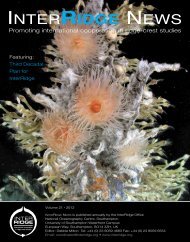Full version, lower resolution, 3.25MB - InterRidge
Full version, lower resolution, 3.25MB - InterRidge
Full version, lower resolution, 3.25MB - InterRidge
Create successful ePaper yourself
Turn your PDF publications into a flip-book with our unique Google optimized e-Paper software.
Working Group Updates<br />
Working Group Updates<br />
Biogeochemical Interactions at Deep-Sea Vents<br />
Chair - N. Le Bris (IFREMER, France)<br />
Members<br />
The WG for Biogeochemical Interactions at Deep-Sea Vents<br />
had one new change in membership for 2008: Huaiyang Zhou<br />
has joined the IR WG for Deep Earth Sampling, and we invited<br />
Xiqiu Han (Second Institute of Oceanography, China)<br />
to join our WG in replacement. Xiqiu's expertise in oxygen<br />
and carbon isotopic signatures of chemosynthetic processes fits<br />
perfectly with the WG objectives, and she will bring a complementary<br />
view from China.<br />
IRTI<br />
Many of our WG activities in this past year have been as a<br />
follow-up to the <strong>InterRidge</strong> Theoretical Institute on Biogeochemical<br />
Interactions at Deep-Sea Vents (Woods Hole, Sept.<br />
10-14, 2007), with the help of the IR office, WHOI colleagues<br />
and chairs of the discussion groups (see article in 2007 Inter-<br />
Ridge Newsletter). Our workshop report is available at:<br />
http://www.interridge.org/files/interridge/IRTI_2007_rept_<br />
full_posted_NLB.pdf.<br />
The development of original strategies and collaborative projects<br />
was a main objective of the IRTI. Beyond smaller-scale<br />
initiatives, the proposition for a coordinated action on an international<br />
basis was issued from the workshop. A common<br />
concern about the capacity of hydrothermal systems to derive<br />
chemical energy to fix CO 2<br />
into biomass arose from four of<br />
the IRTI discussion groups (plume biogeochemistry, life in extreme<br />
environments, hidden biosphere, long-term seafloor ecosystems<br />
changes) and provided the basis for such an initiative.<br />
Below, we highlight in particular two direct outcomes from<br />
the IRTI:<br />
- a SCOR proposal for a synthesis and modelling effort on<br />
which a future large-scale biogeochemical flux experiment<br />
will be based (developed from the several discussion groups<br />
mentioned above), and<br />
- interactions with the GEOTRACES program (another<br />
SCOR-affiliated program) that developed more specifically<br />
from the discussion group on plume biogeochemistry.<br />
New SCOR Working Group<br />
A major achievement of our WG in this past year is the approval<br />
of a new SCOR Working Group, to be co-funded by<br />
<strong>InterRidge</strong>, on "Hydrothermal energy transfer and its impact<br />
on ocean carbon cycles." This new Working Group will be<br />
co-chaired by Nadine Le Bris (IFREMER, France) and Chris<br />
German (WHOI, USA). Currently, the proposal is posted<br />
on the SCOR website at: http://www.scor-int.org/2008GM/<br />
Ridges.pdf. We will also create a mirror webpage for this new<br />
SCOR-<strong>InterRidge</strong> initiative as part of the on-going IR WG for<br />
Biogeochemical Interactions at Deep-Sea Vents.<br />
Hydrothermal venting is widespread throughout all ocean basins,<br />
and the local fixation of carbon and the export of biolimiting<br />
nutrients to the broader ocean may be much greater<br />
than previously recognized. Recent advances in molecular<br />
methods as well as in situ and in vivo experimentation now<br />
provide us new opportunities for a coordinated, integrating effort<br />
in which interdisciplinary approaches and modelling can<br />
be proposed. The main objective is to set the basis for a revised<br />
consideration of the diverse pathways of CO 2<br />
fixation driven<br />
by hydrothermal processes and the potential contribution that<br />
they may make to the global ocean carbon cycle. Our new<br />
SCOR support should allow larger initiatives to be organized<br />
on this topic, involving a broader community of researchers,<br />
including other IR WGs.<br />
This is the first SCOR Working Group in over ten years to be<br />
stimulated from <strong>InterRidge</strong> activities. We congratulate those<br />
involved with the proposal and thank all who were involved<br />
with the discussions at the IRTI. Please feel free to contact Nadine<br />
(Nadine.Le.Bris@ifremer.fr), Chris (cgerman@whoi.edu),<br />
or the <strong>InterRidge</strong> office (coordinator@interridge.org) with<br />
questions or suggestions for the new SCOR Working Group.<br />
Links with the GEOTRACES program<br />
GEOTRACES is one of the newest SCOR-affiliated programs<br />
and seeks to conduct a series of 2-D cross sections of the<br />
oceans, spanning entire ocean basins, to characterize globalocean<br />
biogeochemistry on scales comparable to the WOCE<br />
program's physical oceanographic studies. In the USA the first<br />
priority is a trans-North Atlantic geochemical section, currently<br />
planned to be conducted in 2010, that will include one<br />
station at the TAG hydrothermal mound. A second priority<br />
for U.S. GEOTRACES, identified at a meeting held in Oct.<br />
2008, will be to run a pair of sections in the eastern Pacific.<br />
One will run from north to south between Alaska and Tahiti<br />
and intercept dispersing hydrothermal plumes that span<br />
the Pacific basin, emanating from (from North to South): the<br />
Juan de Fuca Ridge, Loihi Seamount (Hawaii), East Pacific<br />
Rise (EPR) 9-10°N and EPR 10-20°S. The complementary E-<br />
W section will run between Tahiti and Peru, where the western<br />
<strong>InterRidge</strong> News 44 Vol. 17, 2008
















